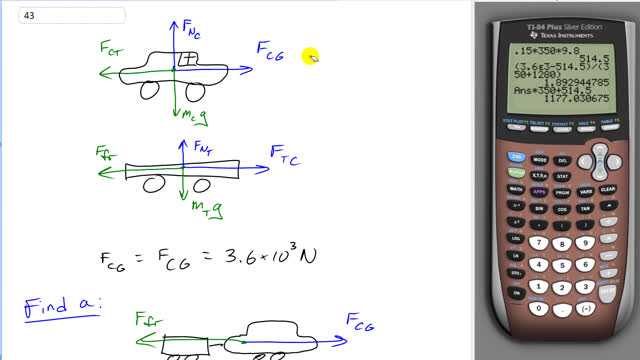
A 1280-kg car pulls a 350-kg trailer. The car exerts a horizontal force of against the ground in order to accelerate. What force does the car exert on the trailer? Assume an effective friction coefficient of 0.15 for the trailer.

In order to watch this solution you need to have a subscription.
This is Giancoli Answers with Mr. Dychko. We'll start by drawing some free body diagrams of the car and the trailer. The car has the force on the car due to the ground. And we're told what force the car exerts on the ground and that would be F on the ground due to the car and FGC and FCG or Newton’s third law pairs, and so, they're equal magnitudes, just opposite directions. So, the car pushes back on the ground with some force that we're told, 3.6 times ten to the three Newtons. And so the ground in turn pushes back on the car to the right, in this picture, with the same size force. And there's this force on the car due to the trailer pulling it back and there's a normal force upwards and gravity down. And the trailer has friction going backwards and has a force on the trailer to the car which is ultimately the question here. And there's a normal force up on the trailer and gravity down. There's no friction force shown on the car because that's already taken into account when we're told this force. The, you know... So, there will be some friction but, you know, after the friction is is dealt with the, and the whatever force is left over for the car to push back on the ground, that's what gets applied. So, you can imagine if there was lots of friction in between the wheels in the axle, that was just making the wheels grind slowly. And you can imagine that the wheels wouldn't be able to apply very much force on the ground. And so, but whatever does get applied onto the ground, of course, gets also applied onto the car because they're Newton's third law pairs. Hopefully that helps a bit. Anyway so, we're going to consider the car and the trailer as a system, as one single thing which has, horizontally speaking, only this force to the right and this force to the left. These internal forces force on the car due to the trailer and on the trailer due to the car, we don't have to draw them when we consider it as one system. And we'll figure out the acceleration of the system because the car and the trailer are going to accelerate at the same rate because they're linked together. And then after we know that acceleration we'll ask, Well, what force would have been needed on the trailer in order to make that acceleration happen? And then that's how we'll get our answer. OK. So, force on the car due to the ground is the same as the force on the ground due to the car. And just different signs but never mind that, just considering magnitudes here. So, 3.67 times ten to three Newtons. And then when we consider the system, we have that force to the right and then we have friction to the left. And then the friction is just due to the trailer here because the friction on the car is already taken into account with this force. And so, the friction is coefficient of kinetic friction times the normal force in the trailer. And the normal force in the trailer will be equal to gravity downwards. And that's mass of the trailer times g. So, 0.15 times 350 kilograms times 9.8 Newtons per kilogram gives us 514.5 Newtons friction force on the trailer. And then we have the force to the right minus the force to the left equals the mass times acceleration, and the mass will be the total of the car and the trailer together. And then we'll divide both sides by this MT plus MC/i<>. and we'll solve for acceleration. And then it's 3.6 times ten to the three Newtons to the right minus the friction, 514.5 Newtons to the left divided by the total mass, 350 plus 12.80 kilograms. And that gives an acceleration of 1.8929 meters per second squared. So, now we turn our attention only to the trailer. And so, there's this force on the trailer due to the car which is the question we have to answer, that's forces to the right. And then minus the force to the left equals the mass of the trailer times its acceleration. And, so we'll add the friction force to both sides. And solve for the force on the trailer due to the car. So, it's the mass of the trailer times acceleration plus friction. So, that's 350 kilograms times the 1.8929 meter per second squared acceleration we figured out before, plus the friction, 514.5, which gives about 1200 Newtons of force on the trailer due to the car.